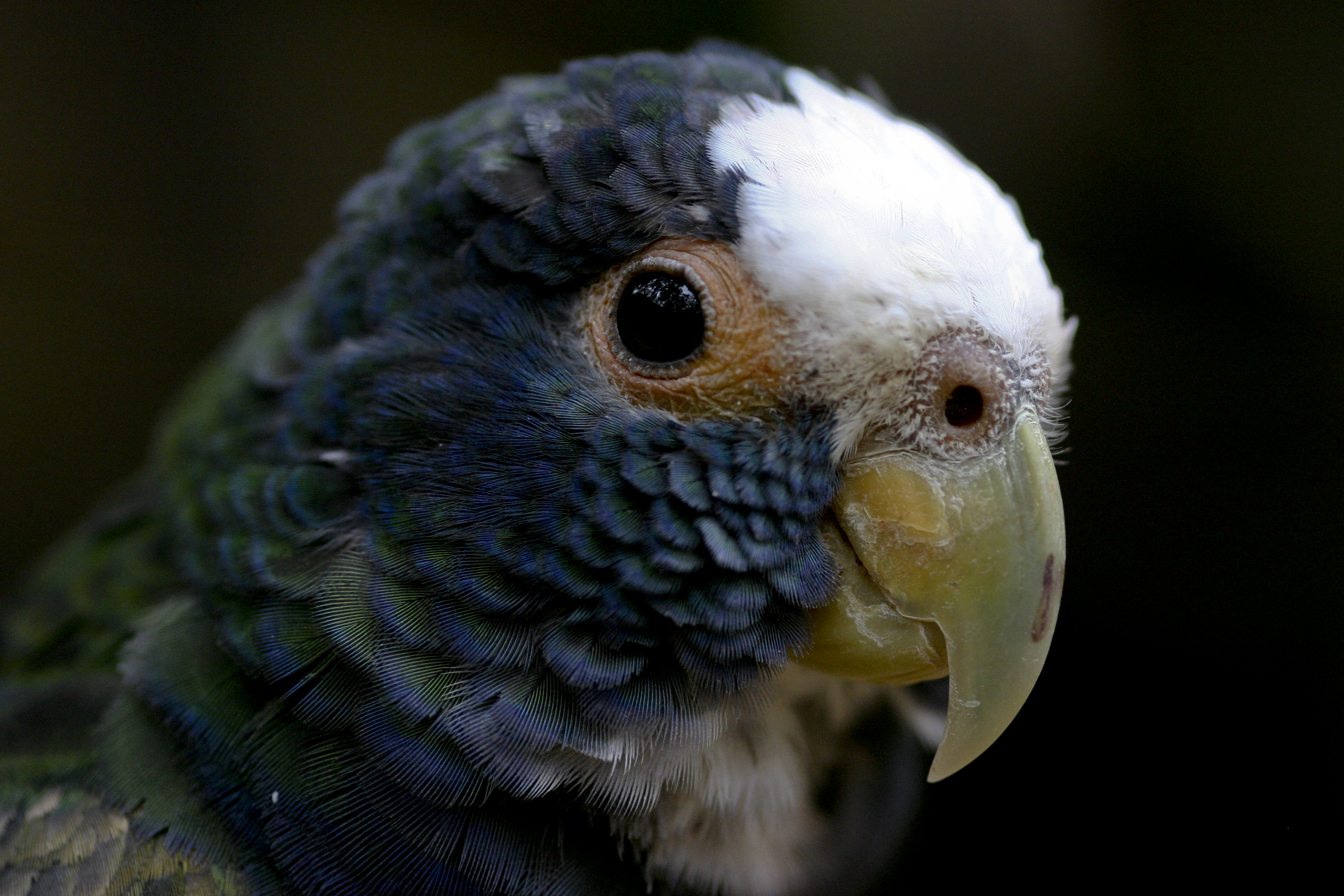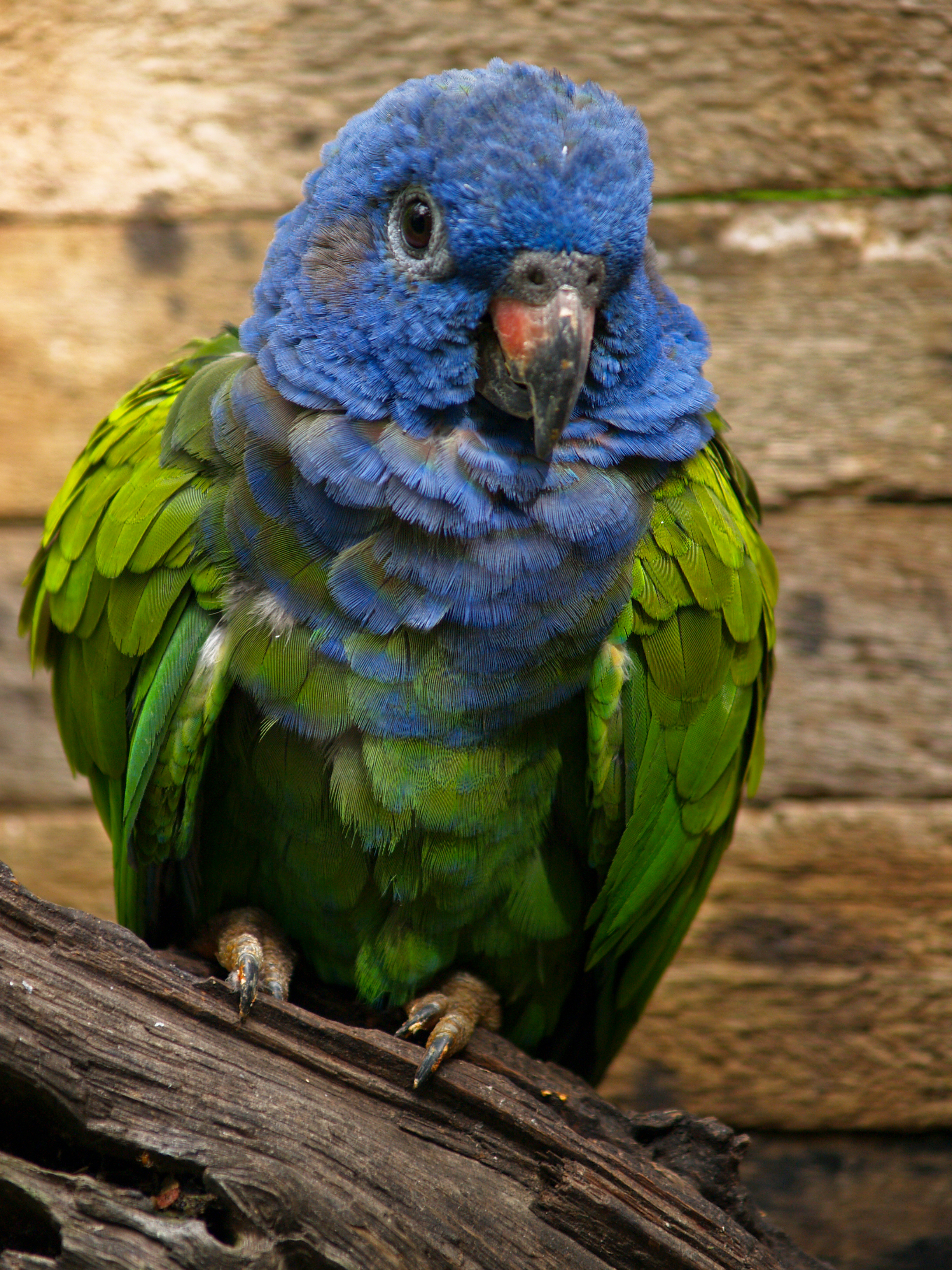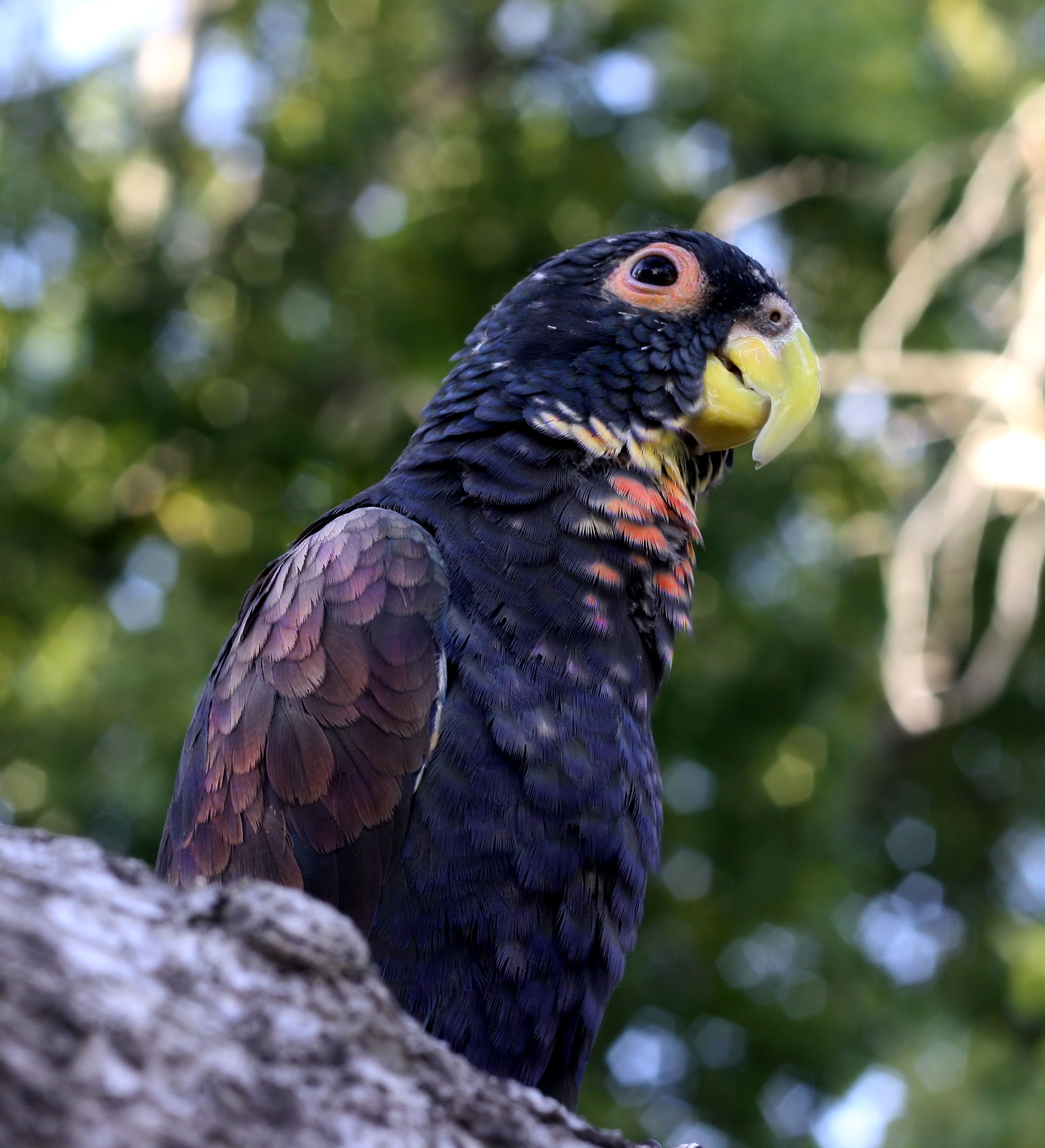|
Pionus
''Pionus'' is a genus of medium-sized parrots native to Mexico, and Central and South America. Characteristic of the genus are the chunky body, bare eye ring (which can vary in color), and short square tail. They are superficially similar to Amazon parrots, but smaller, and in flight their wing-strokes are far deeper. Coloration is generally subdued yet complex compared to member species of the genus ''Amazona''; under bright lighting, their feathers shimmer with iridescent brilliance. All species share bright red undertail coverts; the scientific name of one species, the blue-headed parrot (''P. menstruus''), refers to this. Males and females are similar, with no notable sexual dimorphism. Taxonomy The genus ''Pionus'' was introduced in 1832 by the German naturalist Johann Georg Wagler. The name is from Ancient Greek ''piōn'', ''pionos'' meaning "fat". The type species was designated as the blue-headed parrot by George Robert Gray in 1840. A small number of authorities have ... [...More Info...] [...Related Items...] OR: [Wikipedia] [Google] [Baidu] |
White-crowned Parrot
The white-crowned parrot (''Pionus senilis''), also known as the white-crowned pionus in aviculture, is a small parrot which is a resident breeding species ranging from eastern Mexico to western Panama. It is found in lowlands and foothills locally up to 1600 m altitude in forest canopy and edges, and adjacent semi-open woodland and second growth. The 3 to 6 white egg (biology), eggs are laid in an unlined nest, usually a natural cavity in a tree or a hollow Arecaceae, palm stub. The white-crowned parrot is 24 cm long and weighs 220 g. The adult male has a white forehead and crown, the feature which, likened to an old man's white hair, gave rise to the specific name ''senilis''. The throat is white, and the rest of the head, neck and breast are dull dark blue. The belly is light green, and the upper parts are dark green, with a yellow-olive shoulder patch. In flight, the blue underwings and red vent are conspicuous features. The female white-crowned parrot is simil ... [...More Info...] [...Related Items...] OR: [Wikipedia] [Google] [Baidu] |
Pionus Menstruus
The blue-headed parrot, also known as the blue-headed pionus (''Pionus menstruus'') is a medium-sized parrot of about in length. The body is mostly green, with a blue head and neck, and red undertail coverts. It is a resident in tropical and subtropical South America and southern Central America, from Costa Rica, Venezuela and the Caribbean island of Trinidad south to Bolivia and Brazil. Its habitat is forest and semi-open country, including cultivated areas. It is largely restricted to humid or semi-humid regions, but locally extends into drier habitats, at least along rivers. The blue-headed parrot lays three to five white eggs in a tree cavity. Blue-headed parrots are noisy birds and make light, high-pitched squeaking ''sweenk'' calls. They eat fruit and seeds, and sometimes grain. They roost communally in palm and other trees, and large numbers can be seen at the roost sites at dawn and dusk. Blue-headed parrots are popular as pets. Compared to other parrot species (like am ... [...More Info...] [...Related Items...] OR: [Wikipedia] [Google] [Baidu] |
Pionus Tumultuosus
The plum-crowned parrot (''Pionus tumultuosus'') or plum-crowned pionus is a species of bird in subfamily Arinae of the family Psittacidae, the African and New World parrots. It is found in Bolivia and Peru. Taxonomy and systematics The plum-crowned parrot's taxonomy has not been settled. The International Ornithological Committee and BirdLife International's ''Handbook of the Birds of the World'' consider it to be a full species.HBW and BirdLife International (2022) Handbook of the Birds of the World and BirdLife International digital checklist of the birds of the world. Version 7. Available at: http://datazone.birdlife.org/userfiles/file/Species/Taxonomy/HBW-BirdLife_Checklist_v7_Dec22.zip retrieved December 13, 2022 The South American Classification Committee of the American Ornithological Society (SACC) and the Clements taxonomy treat it and the white-capped parrot (''P. seniloides'') as subspecies of the speckle-faced parrot under the binomial ''P. tumultuosus''.Remsen, J ... [...More Info...] [...Related Items...] OR: [Wikipedia] [Google] [Baidu] |
Pionus Maximiliani
The scaly-headed parrot (''Pionus maximiliani'') is a species of bird in subfamily Arinae of the family Psittacidae, the African and New World parrots. It is also called scaly-headed pionus, Maximilian pionus, Maximilian parrot, Maximilian's pionus, or Maximilian's parrot. It is found in Brazil, Bolivia, Argentina, and Paraguay.Remsen, J. V., Jr., J. I. Areta, E. Bonaccorso, S. Claramunt, A. Jaramillo, D. F. Lane, J. F. Pacheco, M. B. Robbins, F. G. Stiles, and K. J. Zimmer. 30 January 2023. Species Lists of Birds for South American Countries and Territories. https://www.museum.lsu.edu/~Remsen/SACCCountryLists.htm retrieved January 30, 2023 Taxonomy and systematics The scaly-headed parrot has these four subspecies: *''P. m. maximiliani'' (Heinrich Kuhl, Kuhl, 1820) *''P. m. siy'' Charles de Souancé, Souancé, 1856 *''P. m. lacerus'' Ferdinand Heine, Heine, 1884 *''P. m. melanoblepharus'' Alípio de Miranda-Ribeiro, Miranda-Ribeiro, 1920 The scaly-headed parrot and the red-bil ... [...More Info...] [...Related Items...] OR: [Wikipedia] [Google] [Baidu] |
Pionus Seniloides
The white-capped parrot (''Pionus seniloides'') or white-capped pionus is a species of bird in subfamily Arinae of the family Psittacidae, the African and New World parrots. It is found in Colombia, Ecuador, Peru, and Venezuela. Taxonomy and systematics The white-capped parrot's taxonomy has not been settled. The International Ornithological Committee and BirdLife International's ''Handbook of the Birds of the World'' consider it to be a full species.HBW and BirdLife International (2022) Handbook of the Birds of the World and BirdLife International digital checklist of the birds of the world. Version 7. Available at: http://datazone.birdlife.org/userfiles/file/Species/Taxonomy/HBW-BirdLife_Checklist_v7_Dec22.zip retrieved December 13, 2022 The South American Classification Committee of the American Ornithological Society (SACC) and the Clements taxonomy treat it and the plum-crowned parrot (''P. tumultuosus'') as subspecies of the speckle-faced parrot under the binomial ''P. t ... [...More Info...] [...Related Items...] OR: [Wikipedia] [Google] [Baidu] |
Pionus Sordidus
The red-billed parrot (''Pionus sordidus''), also known as coral-billed pionus or red-billed pionus, is a species of bird in subfamily Arinae of the family Psittacidae, the African and New World parrots. It is found in Bolivia, Colombia, Ecuador, Peru, and Venezuela.Remsen, J. V., Jr., J. I. Areta, E. Bonaccorso, S. Claramunt, A. Jaramillo, D. F. Lane, J. F. Pacheco, M. B. Robbins, F. G. Stiles, and K. J. Zimmer. 30 January 2023. Species Lists of Birds for South American Countries and Territories. https://www.museum.lsu.edu/~Remsen/SACCCountryLists.htm retrieved January 30, 2023 Taxonomy and systematics In 1751 the English naturalist George Edwards included an illustration and a description of the red-billed parrot in the fourth volume of his ''A Natural History of Uncommon Birds''. He used the English name "The dusky parrot". Edwards based his hand-colored etching on a live bird in London that was owned by the botanist and Fellow of the Royal Society Peter Collinson. Collins ... [...More Info...] [...Related Items...] OR: [Wikipedia] [Google] [Baidu] |
Pionus Fuscus
The dusky parrot (''Pionus fuscus'') or dusky pionus is a medium-sized mainly dark brownish-gray parrot of the genus ''Pionus'' in the true parrot family. Description The dusky parrot is approximately long. It has a medium-wide gray eye-ring (often fades to white in captivity), a splay of cream-white feathers on its upper neck, a pinkish-red tinge to the belly, and red undertail coverts. The remiges and tail are blue, with the latter red at the base. Overall, the dusky parrot is a dark brownish-gray (tending towards black in poor light) bird. Breeding The dusky parrot nests in tree cavities. The eggs are white and there are usually three or four in a clutch. The female incubates the eggs for about 26 days and the chicks leave the nest about 70 days after hatching. Distribution and habitat The dusky parrot's natural habitat is humid lowland forest. Its range is northern South America, and is centered on the Guiana countries, the Guiana Shield, and the northeastern Amazon Basin. ... [...More Info...] [...Related Items...] OR: [Wikipedia] [Google] [Baidu] |
Pionus Chalcopterus
The bronze-winged parrot (''Pionus chalcopterus'') is a medium-sized pionus parrot 28 cm (11 in) long. It is a short-tailed stocky parrot found in forest and woodland in north-western South America. Description The bronze-winged parrot is mainly dark with a whitish chin patch and its upper chest is speckled with pink feathers. It has short red undertail feathers. The rump, tail and wings are dark blue with lighter blue underwings. The head is dark blue-green; the mantle, back and underparts are dark bronze-green with some blue tipped feathers and sometimes scattered red feathers. Its beak is pale yellow. In adults the ring of bare skin around the eyes is pink. Juveniles have whitish eyerings and their underparts are brownish. Taxonomy Today most authorities consider this species as monotypic, but some continue to recognize two subspecies: * ''P. c. chalcopterus'': west Venezuela, and north and central Colombia. * ''P. b. cyanescens'': south-west Colombia, west Ecuado ... [...More Info...] [...Related Items...] OR: [Wikipedia] [Google] [Baidu] |
Amazon Parrot
Amazon parrots are parrots in the genus ''Amazona''. They are medium-sized, short-tailed parrots native to the Americas, with their range extending from South America to Mexico and the Caribbean. ''Amazona'' is one of the 92 genera of parrots that make up the order Psittaciformes and is in the family Psittacidae, one of three families of true parrots. It contains about thirty species. Most amazons are predominantly green, with accenting colors that depend on the species, and they can be quite vivid. They feed primarily on seeds, nuts, and fruits, supplemented by leafy matter. Many amazons have the ability to mimic human speech and other sounds. Partly because of this, they are popular as pets or companion parrots, and a small industry has developed in breeding parrots in captivity for this market. This popularity has led to many parrots being taken from the wild to the extent that some species have become threatened. The United States and the European Union have made the captur ... [...More Info...] [...Related Items...] OR: [Wikipedia] [Google] [Baidu] |
Parrot
Parrots (Psittaciformes), also known as psittacines (), are birds with a strong curved beak, upright stance, and clawed feet. They are classified in four families that contain roughly 410 species in 101 genus (biology), genera, found mostly in tropics, tropical and subtropics, subtropical regions. The four families are the Psittaculidae (Old World parrots), Psittacidae (African and New World parrots), Cacatuidae (cockatoos), and Strigopidae (New Zealand parrots). One-third of all parrot species are threatened by extinction, with a higher aggregate extinction risk (Red List Index, IUCN Red List Index) than any other comparable bird group. Parrots have a generally pantropical distribution with several species inhabiting temperateness, temperate regions as well. The greatest biodiversity, diversity of parrots is in South America and Australasia. Parrotsalong with Corvidae, ravens, crows, jays, and magpiesare among the most #Intelligence and learning, intelligent birds, and the abil ... [...More Info...] [...Related Items...] OR: [Wikipedia] [Google] [Baidu] |






